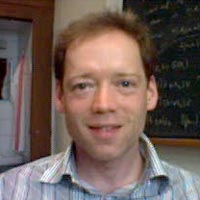| |
Quantum Measurements and Operations for Criptography
and Information Processing
On quantum information processing with graph states
|
 aula DOTTORATO - MERCOLedì 12 OTTOBRE ore 15.00
aula DOTTORATO - MERCOLedì 12 OTTOBRE ore 15.00 |
| |
DIRK
SCHLINGEMANN, Technical University of Braunschweig |
>VITAE:
1987-1996: Study in Physics at the University
of Hamburg (Germany), Diploma and PhD in the field of "algebraic
quantum field theory" at the II. Institute for Theoretical Physics
in the group of Klaus Fredenhagen.
1997-1999: Research project in quantum field
theory an euclidean field theory at the Erwin Schrödinger International
Institute for Mathematical Physics (ESI), Vienna associated with the group
of Jakob Yngvason at the Institut für Theoretische Physik, University
Vienna. Funding by the DFG, the ESI and the Jubiläumsfonds der Oesterreichischen
Nationalbank.
Since 2000: Research associate at the Institut
für Mathematische Physik, Technical University Braunschweig, in the
quantum information theory research group of Reinhard Werner. Funding
by the DFG and EQUIP.
|
 |
| Abstract |
|
| |
Graph states are multiparticle states which are associated
with graphs. Each vertex of the graph corresponds to a single system or
particle. The links describe quantum correlations (entanglement) between
pairs of connected particles. Graph states were initiated independently
by two research groups: On the one hand, graph states were introduced by
Briegel and Rau{\ss}endorf as a resource for a new model of {\em one-way
quantum computing}, where algorithms are implemented by a sequence of measurements
at single particles. On the other hand, graph states were developed in our
research group, as a tool to build quantum error correcting codes, called
{\em graph codes}. The connection between the two approaches was fully realized
in close cooperation. The talk provides a survey of the theory of graph
states. The theoretical and mathematical background for the analysis of
graph states and one-way quantum computing is presented. In particular,
the implementation of quantum error correcting codes is described. In addition
to that, interaction processes are discussed, which enable the creation
of graph states on very large systems. Graph states can be created, for
instance, by an Ising type interaction between next neighbor particles which
sits at the points of an infinitely extended cubic lattice. Based on the
theory of quantum cellular automata, a constructive characterization of
translationally invariant graph states is given. |
| |
 |
